check engine light Alfa Romeo 156 2006 Owner handbook (in English)
[x] Cancel search | Manufacturer: ALFA ROMEO, Model Year: 2006, Model line: 156, Model: Alfa Romeo 156 2006Pages: 357, PDF Size: 5.04 MB
Page 11 of 357
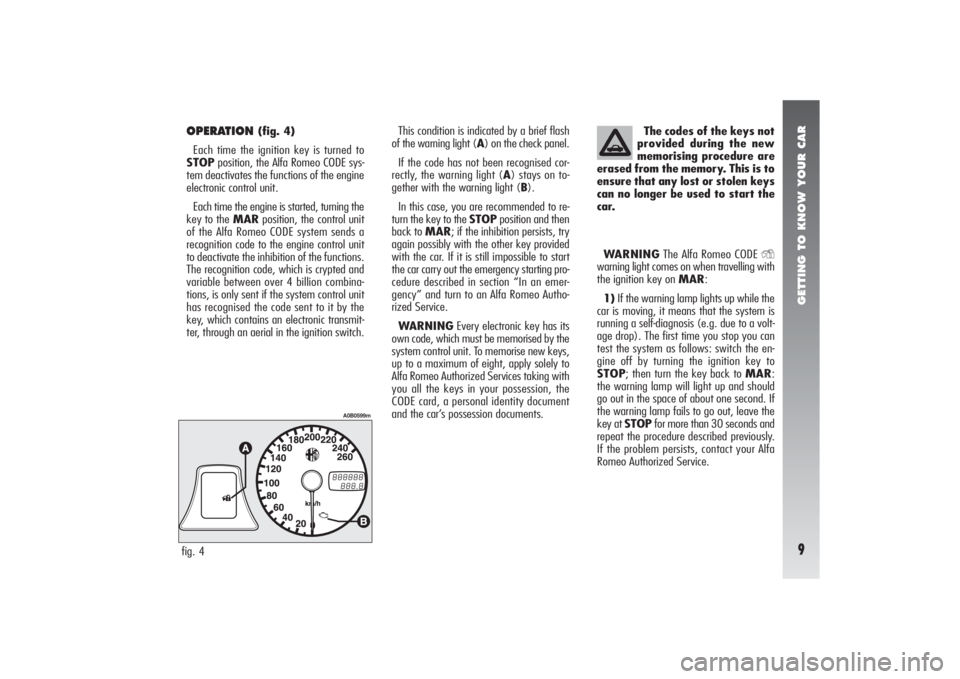
GETTING TO KNOW YOUR CAR9
OPERATION
(fig. 4)
Each time the ignition key is turned to
STOPposition, the Alfa Romeo CODE sys-
tem deactivates the functions of the engine
electronic control unit.
Each time the engine is started, turning the
key to the MARposition, the control unit
of the Alfa Romeo CODE system sends a
recognition code to the engine control unit
to deactivate the inhibition of the functions.
The recognition code, which is crypted and
variable between over 4 billion combina-
tions, is only sent if the system control unit
has recognised the code sent to it by the
key, which contains an electronic transmit-
ter, through an aerial in the ignition switch.This condition is indicated by a brief flash
of the warning light (A) on the check panel.
If the code has not been recognised cor-
rectly, the warning light (A) stays on to-
gether with the warning light (B).
In this case, you are recommended to re-
turn the key to the STOPposition and then
back to MAR; if the inhibition persists, try
again possibly with the other key provided
with the car. If it is still impossible to start
the car carry out the emergency starting pro-
cedure described in section “In an emer-
gency” and turn to an Alfa Romeo Autho-
rized Service.
WARNINGEvery electronic key has its
own code, which must be memorised by the
system control unit. To memorise new keys,
up to a maximum of eight, apply solely to
Alfa Romeo Authorized Services taking with
you all the keys in your possession, the
CODE card, a personal identity document
and the car’s possession documents.
fig. 4
A0B0599m
The codes of the keys not
provided during the new
memorising procedure are
erased from the memory. This is to
ensure that any lost or stolen keys
can no longer be used to start the
car.
WARNINGThe Alfa Romeo CODE
Y
warning light comes on when travelling with
the ignition key on MAR:
1)If the warning lamp lights up while the
car is moving, it means that the system is
running a self-diagnosis (e.g. due to a volt-
age drop). The first time you stop you can
test the system as follows: switch the en-
gine off by turning the ignition key to
STOP; then turn the key back to MAR:
the warning lamp will light up and should
go out in the space of about one second. If
the warning lamp fails to go out, leave the
key at STOPfor more than 30 seconds and
repeat the procedure described previously.
If the problem persists, contact your Alfa
Romeo Authorized Service.
Page 19 of 357
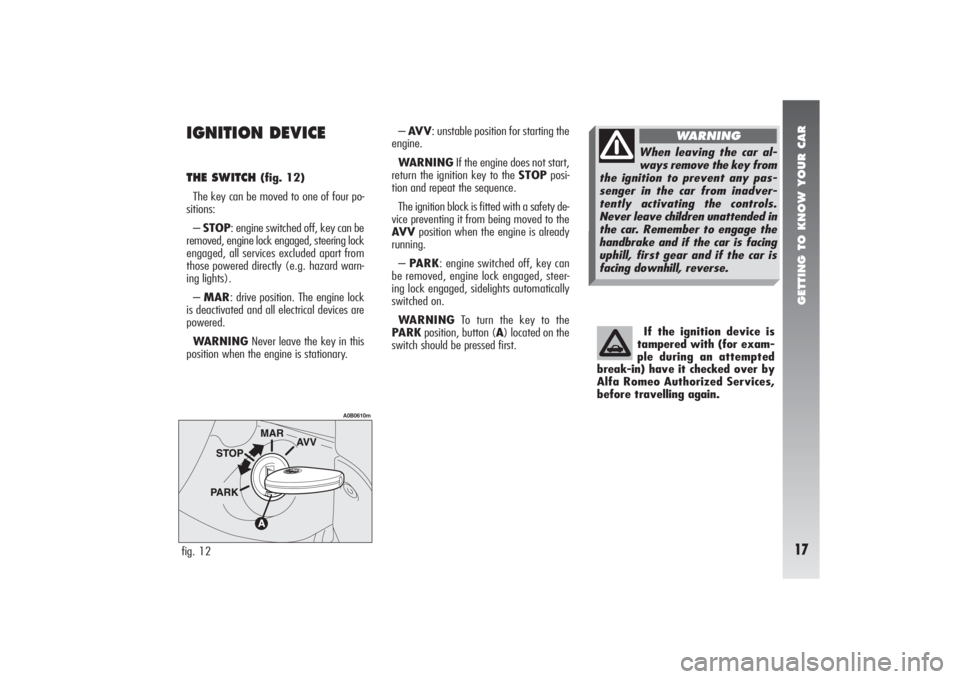
GETTING TO KNOW YOUR CAR17
IGNITION DEVICE THE SWITCH
(fig. 12)
The key can be moved to one of four po-
sitions:
– STOP: engine switched off, key can be
removed, engine lock engaged, steering lock
engaged, all services excluded apart from
those powered directly (e.g. hazard warn-
ing lights).
– MAR: drive position. The engine lock
is deactivated and all electrical devices are
powered.
WARNINGNever leave the key in this
position when the engine is stationary.– AV V: unstable position for starting the
engine.
WARNINGIf the engine does not start,
return the ignition key to the STOPposi-
tion and repeat the sequence.
The ignition block is fitted with a safety de-
vice preventing it from being moved to the
AV Vposition when the engine is already
running.
– PARK: engine switched off, key can
be removed, engine lock engaged, steer-
ing lock engaged, sidelights automatically
switched on.
WARNINGTo turn the key to the
PARKposition, button (A) located on the
switch should be pressed first.If the ignition device is
tampered with (for exam-
ple during an attempted
break-in) have it checked over by
Alfa Romeo Authorized Services,
before travelling again.
fig. 12
A0B0610m
When leaving the car al-
ways remove the key from
the ignition to prevent any pas-
senger in the car from inadver-
tently activating the controls.
Never leave children unattended in
the car. Remember to engage the
handbrake and if the car is facing
uphill, first gear and if the car is
facing downhill, reverse.
WARNING
Page 46 of 357
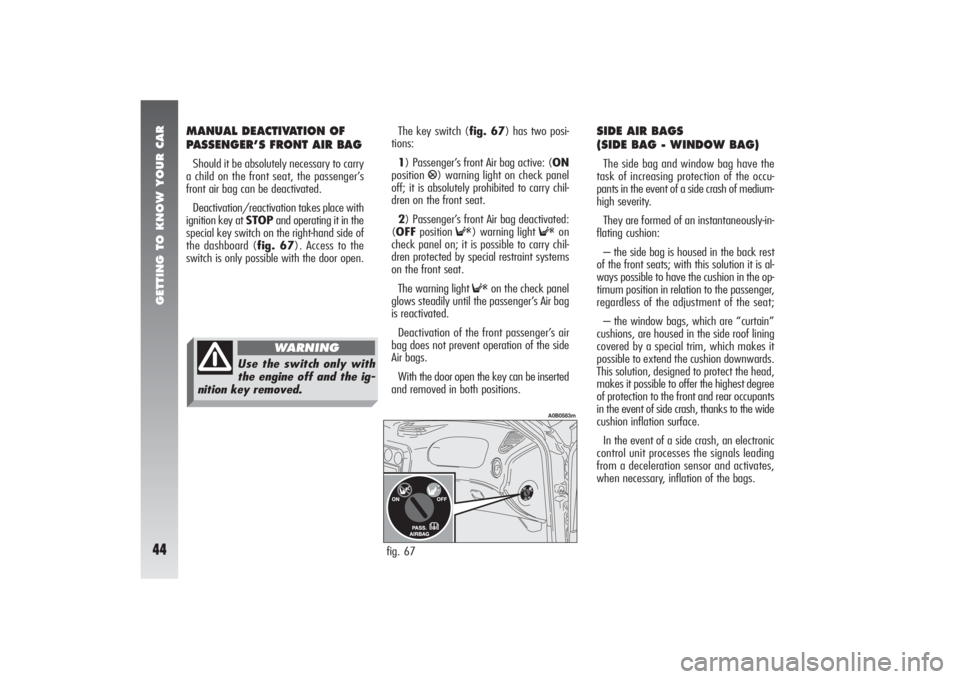
GETTING TO KNOW YOUR CAR44
MANUAL DEACTIVATION OF
PASSENGER’S FRONT AIR BAGShould it be absolutely necessary to carry
a child on the front seat, the passenger’s
front air bag can be deactivated.
Deactivation/reactivation takes place with
ignition key at STOPand operating it in the
special key switch on the right-hand side of
the dashboard (fig. 67). Access to the
switch is only possible with the door open.The key switch (fig. 67) has two posi-
tions:
1) Passenger’s front Air bag active: (ON
position
P) warning light on check panel
off; it is absolutely prohibited to carry chil-
dren on the front seat.
2) Passenger’s front Air bag deactivated:
(OFFposition
F
) warning light
F
on
check panel on; it is possible to carry chil-
dren protected by special restraint systems
on the front seat.
The warning light
F
on the check panel
glows steadily until the passenger’s Air bag
is reactivated.
Deactivation of the front passenger’s air
bag does not prevent operation of the side
Air bags.
With the door open the key can be inserted
and removed in both positions.
SIDE AIR BAGS
(SIDE BAG - WINDOW BAG)The side bag and window bag have the
task of increasing protection of the occu-
pants in the event of a side crash of medium-
high severity.
They are formed of an instantaneously-in-
flating cushion:
– the side bag is housed in the back rest
of the front seats; with this solution it is al-
ways possible to have the cushion in the op-
timum position in relation to the passenger,
regardless of the adjustment of the seat;
– the window bags, which are “curtain”
cushions, are housed in the side roof lining
covered by a special trim, which makes it
possible to extend the cushion downwards.
This solution, designed to protect the head,
makes it possible to offer the highest degree
of protection to the front and rear occupants
in the event of side crash, thanks to the wide
cushion inflation surface.
In the event of a side crash, an electronic
control unit processes the signals leading
from a deceleration sensor and activates,
when necessary, inflation of the bags.
fig. 67
A0B0583m
Use the switch only with
the engine off and the ig-
nition key removed.
WARNING
Page 55 of 357
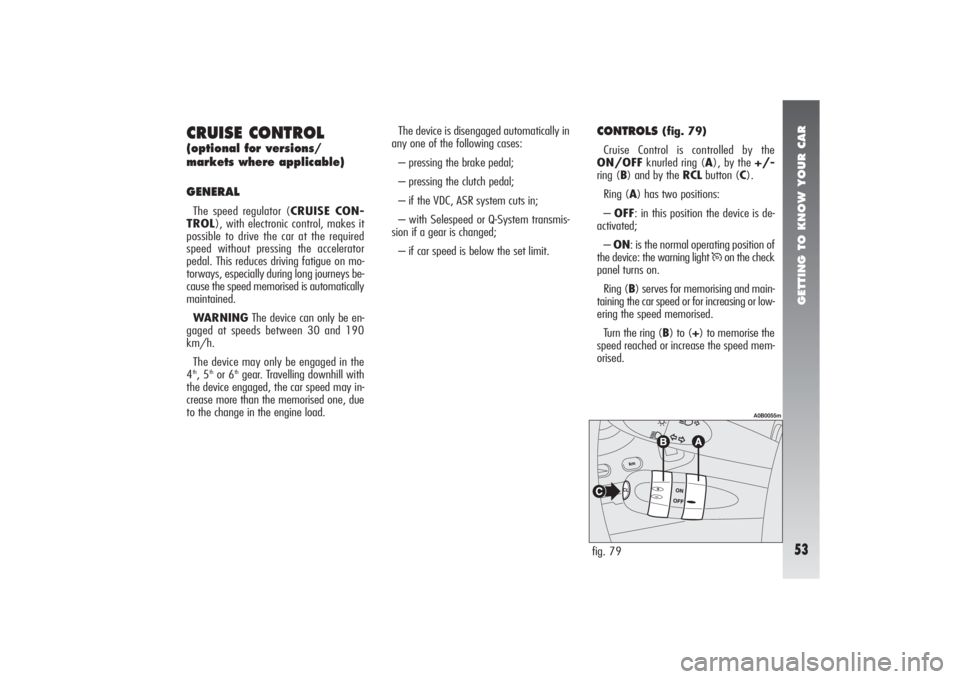
GETTING TO KNOW YOUR CAR53
CRUISE CONTROL(optional for versions/
markets where applicable)
GENERALThe speed regulator (CRUISE CON-
TROL), with electronic control, makes it
possible to drive the car at the required
speed without pressing the accelerator
pedal. This reduces driving fatigue on mo-
torways, especially during long journeys be-
cause the speed memorised is automatically
maintained.
WARNINGThe device can only be en-
gaged at speeds between 30 and 190
km/h.
The device may only be engaged in the
4th, 5
thor 6
thgear. Travelling downhill with
the device engaged, the car speed may in-
crease more than the memorised one, due
to the change in the engine load.The device is disengaged automatically in
any one of the following cases:
– pressing the brake pedal;
– pressing the clutch pedal;
– if the VDC, ASR system cuts in;
– with Selespeed or Q-System transmis-
sion if a gear is changed;
– if car speed is below the set limit.
CONTROLS
(fig. 79)
Cruise Control is controlled by the
ON/OFFknurled ring (A), by the +/-
ring (B) and by the RCLbutton (C).
Ring (A) has two positions:
– OFF: in this position the device is de-
activated;
– ON: is the normal operating position of
the device: the warning light
Ü
on the check
panel turns on.
Ring (B) serves for memorising and main-
taining the car speed or for increasing or low-
ering the speed memorised.
Turn the ring (B) to (+) to memorise the
speed reached or increase the speed mem-
orised.
fig. 79
A0B0055m
Page 57 of 357
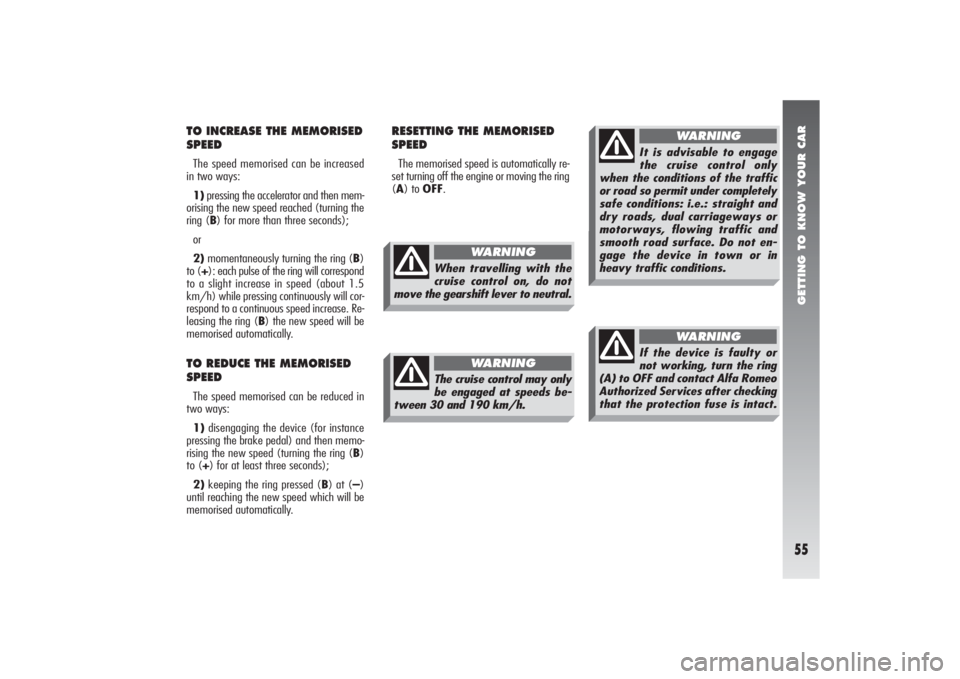
GETTING TO KNOW YOUR CAR55
TO INCREASE THE MEMORISED
SPEEDThe speed memorised can be increased
in two ways:
1)pressing the accelerator and then mem-
orising the new speed reached (turning the
ring (B) for more than three seconds);
or
2)momentaneously turning the ring (B)
to (+): each pulse of the ring will correspond
to a slight increase in speed (about 1.5
km/h) while pressing continuously will cor-
respond to a continuous speed increase. Re-
leasing the ring (B) the new speed will be
memorised automatically.TO REDUCE THE MEMORISED
SPEEDThe speed memorised can be reduced in
two ways:
1)disengaging the device (for instance
pressing the brake pedal) and then memo-
rising the new speed (turning the ring (B)
to (+) for at least three seconds);
2)keeping the ring pressed (B) at (–)
until reaching the new speed which will be
memorised automatically.
RESETTING THE MEMORISED
SPEEDThe memorised speed is automatically re-
set turning off the engine or moving the ring
(A) to OFF.
When travelling with the
cruise control on, do not
move the gearshift lever to neutral.
WARNING
The cruise control may only
be engaged at speeds be-
tween 30 and 190 km/h.
WARNING
It is advisable to engage
the cruise control only
when the conditions of the traffic
or road so permit under completely
safe conditions: i.e.: straight and
dry roads, dual carriageways or
motorways, flowing traffic and
smooth road surface. Do not en-
gage the device in town or in
heavy traffic conditions.
WARNING
If the device is faulty or
not working, turn the ring
(A) to OFF and contact Alfa Romeo
Authorized Services after checking
that the protection fuse is intact.
WARNING
Page 58 of 357
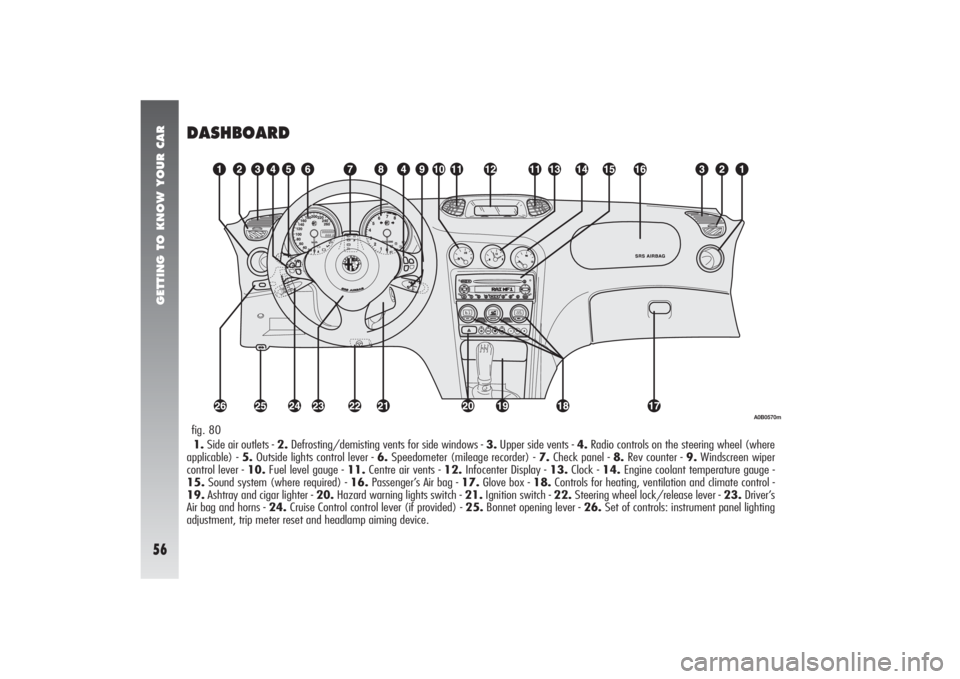
GETTING TO KNOW YOUR CAR56
DASHBOARD1.Side air outlets - 2.Defrosting/demisting vents for side windows - 3.Upper side vents - 4.Radio controls on the steering wheel (where
applicable) - 5.Outside lights control lever - 6.Speedometer (mileage recorder) - 7.Check panel - 8.Rev counter - 9.Windscreen wiper
control lever - 10.Fuel level gauge - 11.Centre air vents - 12.Infocenter Display - 13.Clock - 14.Engine coolant temperature gauge -
15.Sound system (where required) - 16.Passenger’s Air bag - 17.Glove box - 18.Controls for heating, ventilation and climate control -
19.Ashtray and cigar lighter - 20.Hazard warning lights switch - 21.Ignition switch - 22.Steering wheel lock/release lever - 23.Driver’s
Air bag and horns - 24.Cruise Control control lever (if provided) - 25.Bonnet opening lever - 26.Set of controls: instrument panel lighting
adjustment, trip meter reset and headlamp aiming device.fig. 80
A0B0570m
Page 59 of 357
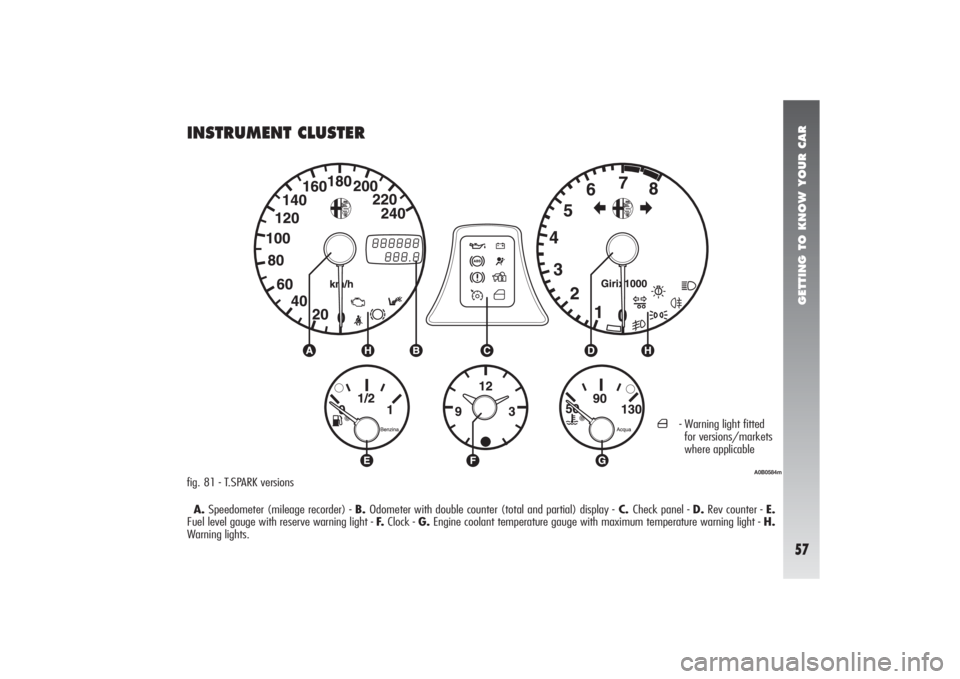
GETTING TO KNOW YOUR CAR57
INSTRUMENT CLUSTERfig. 81 - T.SPARK versions
A.Speedometer (mileage recorder) - B. Odometer with double counter (total and partial) display -C. Check panel - D.Rev counter - E.
Fuel level gauge with reserve warning light - F.Clock - G.Engine coolant temperature gauge with maximum temperature warning light - H.
Warning lights.
A0B0584m
´
- Warning light fitted
for versions/markets
where applicable
Page 60 of 357
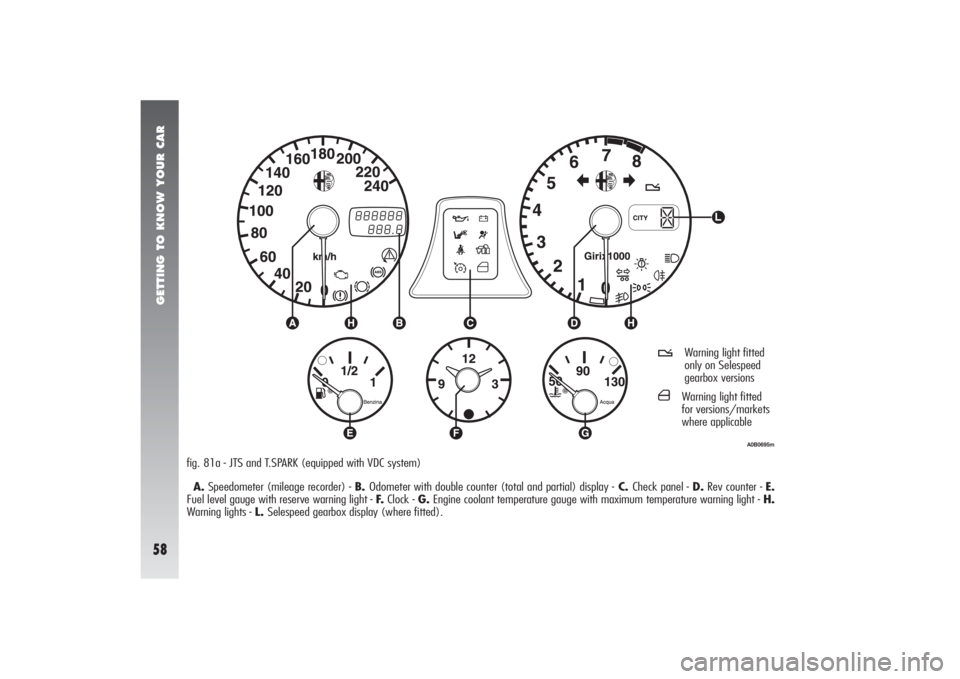
GETTING TO KNOW YOUR CAR58
A0B0695m
fig. 81a - JTS and T.SPARK (equipped with VDC system)
A.Speedometer (mileage recorder) - B. Odometer with double counter (total and partial) display -C. Check panel - D.Rev counter - E.
Fuel level gauge with reserve warning light - F.Clock - G.Engine coolant temperature gauge with maximum temperature warning light - H.
Warning lights - L. Selespeed gearbox display (where fitted).
t
Warning light fitted
only on Selespeed
gearbox versions
´
Warning light fitted
for versions/markets
where applicable
Page 61 of 357
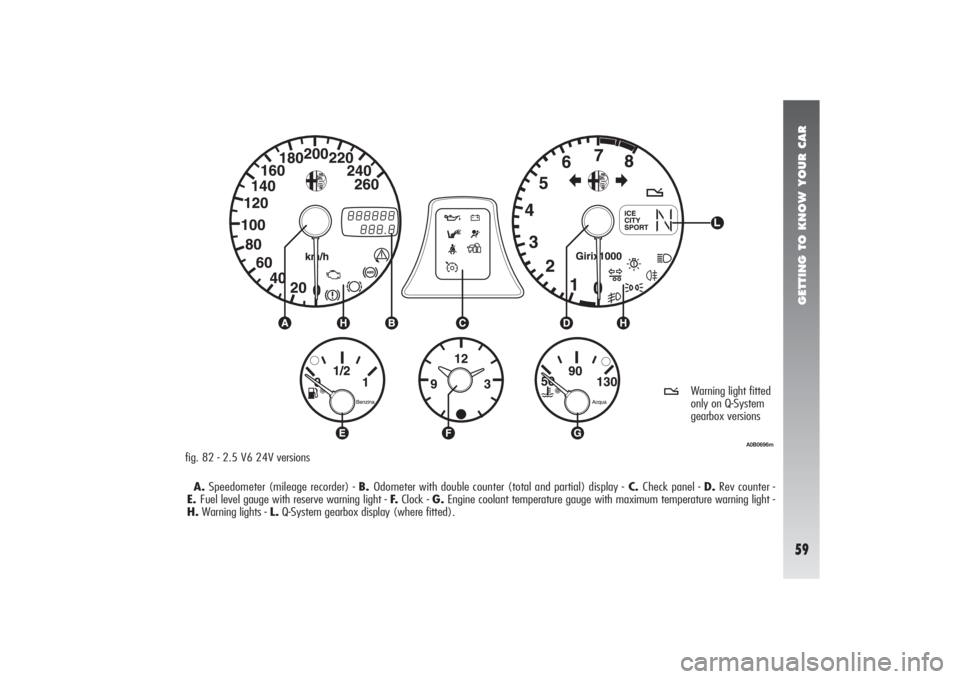
GETTING TO KNOW YOUR CAR59
A.Speedometer (mileage recorder) - B. Odometer with double counter (total and partial) display -C. Check panel - D.Rev counter -
E.Fuel level gauge with reserve warning light - F.Clock - G.Engine coolant temperature gauge with maximum temperature warning light -
H.Warning lights - L.Q-System gearbox display (where fitted).fig. 82 - 2.5 V6 24V versions
A0B0696m
t
Warning light fitted
only on Q-System
gearbox versions
Page 62 of 357
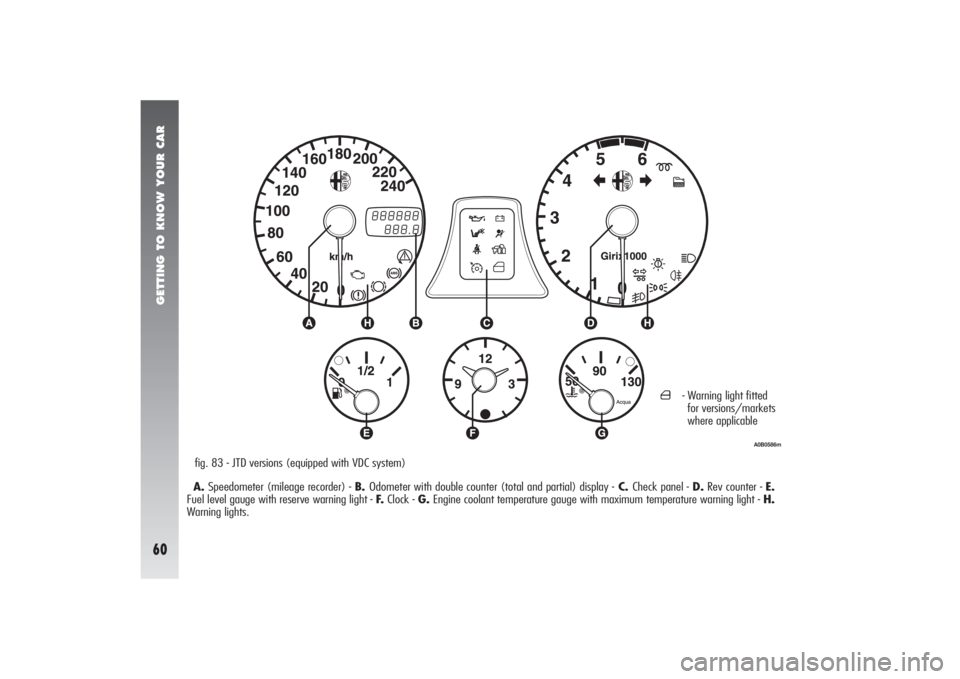
GETTING TO KNOW YOUR CAR60
A.Speedometer (mileage recorder) - B. Odometer with double counter (total and partial) display -C. Check panel - D.Rev counter - E.
Fuel level gauge with reserve warning light - F.Clock - G.Engine coolant temperature gauge with maximum temperature warning light - H.
Warning lights.fig. 83 - JTD versions (equipped with VDC system)
A0B0586m
´
- Warning light fitted
for versions/markets
where applicable